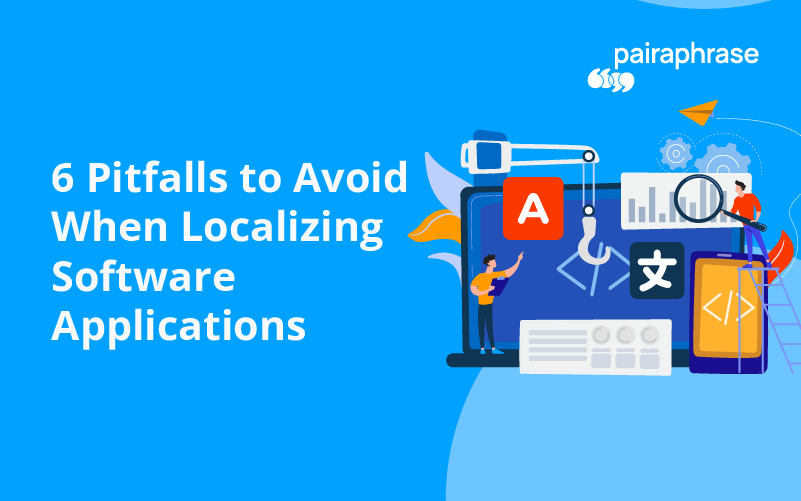As a software localization engineer or program manager, you understand the importance of localizing software applications in a global market. It's not just about language translation; it's about creating an inclusive user experience that resonates across diverse cultures. Not a simple undertaking.
Amidst the complexities of this process lie several pitfalls that can hinder the effectiveness of localizing software products. Below are some crucial missteps to avoid when you localize your software solutions.
Top 6 Software Localization Mistakes to Steer Clear of
1. Overlooking Cultural Context
One of the most common pitfalls in localizing software apps is ignoring cultural nuances. Language isn't the only aspect that needs translation; understanding the cultural context is equally vital.
Colors, symbols, and even gestures can carry different meanings across cultures. Neglecting these subtleties can lead to misunderstandings or even offense among users. You must delve deep into the cultural fabric of the target markets to ensure a harmonious adaptation of the software.
2. Using Litefral Translations
A frequent mistake engineers make in localizing software platforms is relying solely on literal translations. While it's essential to maintain accuracy, direct translations can lead to awkward phrasings or loss of context.
Idioms, colloquialisms, and metaphors may not have direct equivalents in other languages. It's crucial to opt for translations that preserve the intended meaning and user experience rather than word-for-word renditions.
Translation management systems are a great solution to these problems and can be easily integrated into your localization workflow. In general, they help to support agile localization by efficiently translating resource files and other various file formats in a variety of target languages and providing a translation editing environment.
Use an AI-powered translation management system with a clean UI, translation memory, machine translation and terminology management.
3. Disregarding User Interface Adaptation
Another pitfall to avoid when localizing software products is disregarding the adaptation of the user interface (UI). Simply translating text without considering UI elements can result in a disjointed or confusing interface.
Text expansion or contraction in different languages may affect the layout and design. Neglecting these aspects can diminish the user experience and make the software less intuitive for users from diverse linguistic backgrounds.
For example, lack of white space is a prevalent issue. Spanish, French and German, for instance, all experience 20-40% language growth. This can cause UI problems if not accounted for.
4. Side-Stepping Tests in Different Environments
Failure to conduct thorough testing in various environments is a significant oversight in localizing software solutions. Different regions may have distinct technical environments, including localized operating systems, browsers, or devices.
Neglecting to test the software thoroughly in these environments can lead to functionality issues, bugs, or compatibility problems. Rigorous testing across diverse setups is crucial to ensure seamless functionality across the board.
5. Underestimating Legal and Regulatory Compliance
One more pitfall to avoid when you localize software applications is underestimating legal and regulatory compliance. Different regions have diverse laws and regulations concerning data privacy, accessibility, and content.
If you don’t adhere to these, it can result in legal repercussions or exclusion from specific markets. Integrating compliance checks into the software localization process is crucial to ensure the software meets all necessary legal requirements.
6. Localizing Software Once and then Neglecting Ongoing Efforts
A common oversight is neglecting continuous updates and maintenance in localizing software solutions. Languages evolve, and so do user preferences and cultural trends.
Failing to update and adapt the localized software can lead to outdated content, causing users to disengage or misunderstand the information. Regular updates and maintenance are essential for sustaining user engagement and relevance in various markets.
Conclusion
The localization of software applications successfully requires a comprehensive approach before you start translating files. This includes considerations of language, culture, design, functionality, compliance, and ongoing maintenance.
Avoiding these pitfalls empowers your team to ensure a more effective and smoother adaptation for global audiences. Embracing market intricacies and understanding diverse user needs are integral to developing software that transcends linguistic and cultural boundaries.
Ultimately, your organization’s bottom line will benefit from following software localization best practices.
Localizing Software is Easier with Pairaphrase
Want to streamline the translation process when localizing software? Make it fast and easy with Pairaphrase, the AI-powered translation management system for teams that value faster, smarter and safer translation.
Pairaphrase supports your agile product development cycle by helping you translate faster, smarter and safer.
Get Started
or share this article with a colleague———
Related:
How to Improve Collaboration on Software Localization Projects


.png)

.png)



